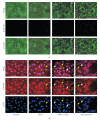TNFalpha induces choroid plexus epithelial cell barrier alterations by apoptotic and nonapoptotic mechanisms
- PMID: 20369072
- PMCID: PMC2847764
- DOI: 10.1155/2010/307231
TNFalpha induces choroid plexus epithelial cell barrier alterations by apoptotic and nonapoptotic mechanisms
Abstract
The choroid plexus epithelium constitutes the structural basis of the blood-cerebrospinal fluid barrier. Since the cytokine TNFalpha is markedly increased during inflammatory diseases in the blood and the central nervous system, we investigated by which mechanisms TNFalpha induces barrier alteration in porcine choroid plexus epithelial cells. We found a dose-dependent decrease of transepithelial electrical resistance, increase of paracellular inulin-flux, and induction of histone-associated DNA fragmentation and caspase-3 activation after TNFalpha stimulation. This response was strongly aggravated by the addition of cycloheximide and could partially be inhibited by the NF-kappaB inhibitor CAPE, but most effectively by the pan-caspase-inhibitor zVAD-fmk and not by the JNK inhibitor SP600125. Partial loss of cell viability could also be attenuated by CAPE. Immunostaining showed cell condensation and nuclear binding of high-mobility group box 1 protein as a sign of apoptosis after TNFalpha stimulation. Taken together our findings indicate that TNFalpha compromises PCPEC barrier function by caspase and NF-kappaB dependent mechanisms.
Figures








Similar articles
-
Cell death, caspase activation, and HMGB1 release of porcine choroid plexus epithelial cells during Streptococcus suis infection in vitro.Brain Res. 2006 Jul 19;1100(1):1-12. doi: 10.1016/j.brainres.2006.05.041. Epub 2006 Jun 15. Brain Res. 2006. PMID: 16781680
-
MMPs contribute to TNF-alpha-induced alteration of the blood-cerebrospinal fluid barrier in vitro.Am J Physiol Cell Physiol. 2007 Sep;293(3):C855-64. doi: 10.1152/ajpcell.00470.2006. Epub 2007 May 16. Am J Physiol Cell Physiol. 2007. PMID: 17507431
-
Barrier function of porcine choroid plexus epithelial cells is modulated by cAMP-dependent pathways in vitro.Brain Res. 2000 Jan 17;853(1):115-24. doi: 10.1016/s0006-8993(99)02317-3. Brain Res. 2000. PMID: 10627315
-
Usefulness and limitation of primary cultured porcine choroid plexus epithelial cells as an in vitro model to study drug transport at the blood-CSF barrier.Adv Drug Deliv Rev. 2004 Oct 14;56(12):1859-73. doi: 10.1016/j.addr.2004.07.012. Adv Drug Deliv Rev. 2004. PMID: 15381337 Review.
-
A Hidden Epithelial Barrier in the Brain with a Central Role in Regulating Brain Homeostasis. Implications for Aging.Ann Am Thorac Soc. 2016 Dec;13 Suppl 5:S407-S410. doi: 10.1513/AnnalsATS.201609-676AW. Ann Am Thorac Soc. 2016. PMID: 28005425 Review.
Cited by
-
The choroid plexus-a multi-role player during infectious diseases of the CNS.Front Cell Neurosci. 2015 Mar 12;9:80. doi: 10.3389/fncel.2015.00080. eCollection 2015. Front Cell Neurosci. 2015. PMID: 25814932 Free PMC article. Review.
-
Choroid Plexus Pathophysiology.Annu Rev Pathol. 2025 Jan;20(1):193-220. doi: 10.1146/annurev-pathmechdis-051222-114051. Epub 2025 Jan 2. Annu Rev Pathol. 2025. PMID: 39383438 Review.
-
Polar Infection of Echovirus-30 Causes Differential Barrier Affection and Gene Regulation at the Blood-Cerebrospinal Fluid Barrier.Int J Mol Sci. 2020 Aug 29;21(17):6268. doi: 10.3390/ijms21176268. Int J Mol Sci. 2020. PMID: 32872518 Free PMC article.
-
Paclitaxel triggers molecular and cellular changes in the choroid plexus.Front Pain Res (Lausanne). 2024 Nov 25;5:1488369. doi: 10.3389/fpain.2024.1488369. eCollection 2024. Front Pain Res (Lausanne). 2024. PMID: 39654799 Free PMC article.
-
The choroid plexus and its role in the pathogenesis of neurological infections.Fluids Barriers CNS. 2022 Sep 10;19(1):75. doi: 10.1186/s12987-022-00372-6. Fluids Barriers CNS. 2022. PMID: 36088417 Free PMC article. Review.
References
-
- Strazielle N, Ghersi-Egea J-F. Choroid plexus in the central nervous system: biology and physiopathology. Journal of Neuropathology and Experimental Neurology. 2000;59(7):561–574. - PubMed
-
- Engelhardt B, Wolburg-Buchholz K, Wolburg H. Involvement of the choroid plexus in central nervous system inflammation. Microscopy Research and Technique. 2001;52(1):112–129. - PubMed
-
- Balda MS, Matter K. Tight junctions. Journal of Cell Science. 1998;111(5):541–547. - PubMed
-
- Denker BM, Nigam SK. Molecular structure and assembly of the tight junction. American Journal of Physiology. 1998;274(1):F1–F9. - PubMed
Publication types
MeSH terms
Substances
LinkOut - more resources
Full Text Sources
Research Materials

